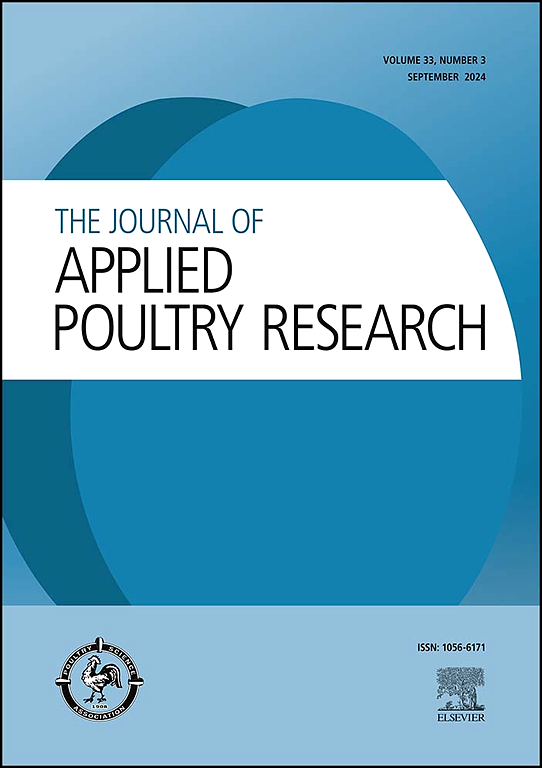Fagopyrum dibotrys protects gut health in broiler chickens fed oxidized oil
IF 2
3区 农林科学
Q2 AGRICULTURE, DAIRY & ANIMAL SCIENCE
引用次数: 0
Abstract
The objective was to evaluate protective effects of Fagopyrum dibotrys (perennial buckwheat), antibiotics, or both, on gut health in broiler chickens fed oxidized soybean oil. Male Tiejiaoma broilers (n=240), at 1 d of age, were randomly and equally assigned to 4 treatment groups that were fed: a basal diet (Ctr group) or a diet with 60 mg flavomycin+270 mg chlortetracycline/kg diet (Anti group), with (Anti + Fag) or without 2% F. dibotrys (Fag group). In the present study, the inflammatory factor levels and gene expression levels were determined using commercial ELISA kits and qRT-PCR analysis, respectively. The mRNA expression profiles of ileal tissue were analyzed by RNA sequencing, and the cecal microbiota were sequenced using 16S rDNA amplicon sequencing. The Anti group had the best (P < 0.05) feed conversion ratio and greater (P < 0.05) body weight gain compared to Fag and Anti + Fag, In ileal tissue, the Fag group had significantly decreased concentrations of proinflammatory cytokines (IL-6, IL-1β, IFN-γ and TNF-α) but increased IL-22, and significantly increased mRNA expression of ZO-1, TNF-α, IFN-γ, TGF-β, IL-22, Nrf2, SOD1, and CAT. However, all these effects were reversed in the Anti + Fag group. Based on 16S rDNA, the Fag group had significantly increased microbial diversity in cecum, with a distinct microbiome based on principal coordinates analysis (PCoA), including increases in relative abundance of Firmicutes in phyla, and in genera Candidatus_Arthromitus, Streptococcus, Enterococcus, and Lactobacillus. However, those changes in cecal microbes did not occur in Anti + Fag group. Based on RNA-seq, there were 771, 2187, 825, 1774, 898, 2127 differentially expressed (DE) mRNAs detected between Anti vs Ctr, Fag vs Ctr, Anti + Fag vs Ctr, Fag vs Anti, Anti + Fag vs Anti, and Anti + Fag vs Fag, respectively. Based on Kyoto Encyclopedia of Genes analysis (KEGG), DE mRNA were enriched in categories and pathways related to gap junction, oxidative phosphorylation, ECM-receptor interaction, focal adhesion, as well as the PPAR, TGF-β, and calcium signalling pathways. In summary, F. dibotrys ameliorated the inflammatory response by regulating expression of TNF-α, IFN-γ, TGF-β and IL-22; enhanced antioxidant activity by increasing expression of Nrf2, SOD1, and CAT; facilitated growth of Candidatus_Arthromitus, Streptococcus, Enterococcus and Lactobacillus; and regulated gene expression profile and signal pathway enrichment in ileal tissue.
苦荞麦对饲喂氧化油肉鸡肠道健康的保护作用
目的是评估荞麦(多年生荞麦),抗生素,或两者兼有,对食用氧化大豆油的肉鸡肠道健康的保护作用。选取1日龄的雄性铁交马肉鸡240只,随机分为4个处理组,分别饲喂基础饲粮(Ctr组)、黄霉素60 mg +黄霉素270 mg /kg饲粮(抗组)、黄霉素+黄霉素(抗组)和不添加2%二氮化菌(Fag组)。在本研究中,分别使用商用ELISA试剂盒和qRT-PCR分析来检测炎症因子水平和基因表达水平。采用RNA测序法分析回肠组织mRNA表达谱,采用16S rDNA扩增子测序法对盲肠菌群进行测序。抗组(P <;0.05)饲料系数及更大(P <;在回肠组织中,Fag组促炎因子(IL-6、IL-1β、IFN-γ和TNF-α)浓度显著降低,IL-22浓度显著升高,ZO-1、TNF-α、IFN-γ、TGF-β、IL-22、Nrf2、SOD1和CAT mRNA表达显著升高。然而,在Anti + Fag组,所有这些作用都被逆转了。基于16S rDNA, Fag组显著增加了盲肠内的微生物多样性,基于主坐标分析(PCoA),具有独特的微生物组,包括门中厚壁菌门的相对丰度增加,以及Candidatus_Arthromitus属,链球菌,肠球菌和乳杆菌属。而Anti + Fag组盲肠微生物没有发生这些变化。基于RNA-seq, Anti - vs Ctr、Fag vs Ctr、Anti + Fag vs Ctr、Fag vs Anti、Anti + Fag vs Anti和Anti + Fag vs Fag之间分别检测到771、2187、825、1774、898、2127个差异表达mrna。基于京都基因百科全书分析(KEGG), DE mRNA富集在与间隙连接、氧化磷酸化、ecm受体相互作用、局灶粘附以及PPAR、TGF-β和钙信号通路相关的类别和途径中。综上所述,F. dibotrys通过调节TNF-α、IFN-γ、TGF-β和IL-22的表达来改善炎症反应;通过增加Nrf2、SOD1和CAT的表达增强抗氧化活性;促进了候选菌、关节菌、链球菌、肠球菌和乳杆菌的生长;调控回肠组织基因表达谱和信号通路富集。
本文章由计算机程序翻译,如有差异,请以英文原文为准。
求助全文
约1分钟内获得全文
求助全文
来源期刊

Journal of Applied Poultry Research
农林科学-奶制品与动物科学
CiteScore
4.10
自引率
10.50%
发文量
80
审稿时长
104 days
期刊介绍:
The Journal of Applied Poultry Research (JAPR) publishes original research reports, field reports, and reviews on breeding, hatching, health and disease, layer management, meat bird processing and products, meat bird management, microbiology, food safety, nutrition, environment, sanitation, welfare, and economics. As of January 2020, JAPR will become an Open Access journal with no subscription charges, meaning authors who publish here can make their research immediately, permanently, and freely accessible worldwide while retaining copyright to their work. Papers submitted for publication after October 1, 2019 will be published as Open Access papers.
The readers of JAPR are in education, extension, industry, and government, including research, teaching, administration, veterinary medicine, management, production, quality assurance, product development, and technical services. Nutritionists, breeder flock supervisors, production managers, microbiologists, laboratory personnel, food safety and sanitation managers, poultry processing managers, feed manufacturers, and egg producers use JAPR to keep up with current applied poultry research.
 求助内容:
求助内容: 应助结果提醒方式:
应助结果提醒方式:


